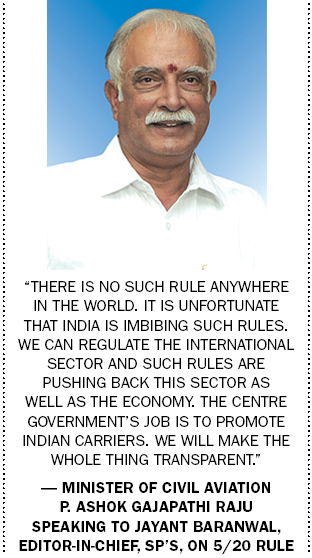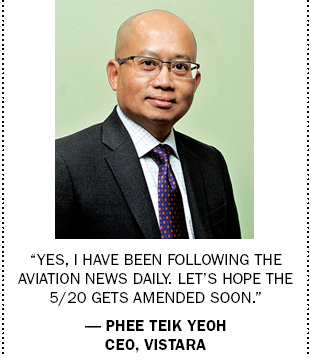INDIAN ARMED FORCES CHIEFS ON OUR RELENTLESS AND FOCUSED PUBLISHING EFFORTS

SP Guide Publications puts forth a well compiled articulation of issues, pursuits and accomplishments of the Indian Army, over the years

"Over the past 60 years, the growth of SP Guide Publications has mirrored the rising stature of Indian Navy. Its well-researched and informative magazines on Defence and Aerospace sector have served to shape an educated opinion of our military personnel, policy makers and the public alike. I wish SP's Publication team continued success, fair winds and following seas in all future endeavour!"

Since, its inception in 1964, SP Guide Publications has consistently demonstrated commitment to high-quality journalism in the aerospace and defence sectors, earning a well-deserved reputation as Asia's largest media house in this domain. I wish SP Guide Publications continued success in its pursuit of excellence.
1 Year of Modi Government
The Indian civil aviation industry needs decisive and concerted action by the government if it has to be extricated from the morass that it has descended into
 | By Air Marshal B.K. Pandey (Retd) Former Air Officer Commanding-in-Chief of Training Command, IAF |
In the month of April this year as the Modi-led NDA Government was approaching completion of one year in power, under directions of the office of the Prime Minister, it began to compile a list cataloguing its achievements since it had taken over the reins of the nation on May 26, 2014. On its part, the Indian Ministry of Civil Aviation too undertook this exercise to take stock of the situation. Compared to other segments of the national economy however, the civil aviation industry is generally seen by the majority in the country as being just a privilege of the affluent sections of the society and not really of any critical importance to the nation.
Unfortunately, the point that is lost sight of on account of the prevailing misperception is the contribution that the Indian civil aviation industry is capable of making to the national economy for it to attain a global stature. Both the nation and the industry did have hopes that the civil aviation industry that has been literally struggling for survival, will receive due attention of the new government. Hopes in this regard were raised when soon after coming to power, the government had indicated intent to take positive steps to reform and revive the civil aviation industry. In fact, on May 29, 2014, P. Ashok Gajapathi Raju, the newly appointed Minister of Civil Aviation, stated “We will strive to create a level-playing field for all the players and make the aviation sector more people-oriented.”
Honour Restored

One of the high priority tasks before the new government was to restore the prestige of the Indian civil aviation industry which had been severely dented on account of the downgrade in January 2014 by the Federal Aviation Administration (FAA) of the United States of its safety rating from Category 1 to Category 2 placing it on a par with the civil aviation industry of Bangladesh, Ghana, Indonesia, the Philippines and Nicaragua. The fact that safety rating of Indian civil aviation was upgraded by the FAA to Category 1 in April this year was not only restoration of honour for the Indian civil aviation industry on the global scene but could also be regarded as a major success registered by the government in power and perhaps the first feather in its cap. Unfortunately, there has hardly been any change of substance or significance in other segments of civil aviation.
A Troublesome Inheritance
The Modi Government had inherited a civil aviation industry that was not in a very healthy state. Despite the sustained growth in both passenger and cargo traffic, with the exception of IndiGo Airlines, all other carriers were burdened with cumulative losses and were literally engaged in a struggle for survival. Jet Airways, one of the first airlines in the private sector to be launched in India, managed to survive through a lifeline provided by Etihad Airways, one of the most successful airlines in the Middle East. SpiceJet that was recording high load factors and was also commanding a respectable market share, for some reasons suddenly went into a nose-dive only to be rescued by its original benefactor Ajay Singh who is now in the process of putting the ailing carrier back on track. Earlier on, the glamorous Kingfisher Airlines that had bought off Air Deccan, despite the strong financial backing of the UB Group, had failed to survive. The national carrier Air India that has accumulated humongous losses and has been languishing under a heavy debt burden, has been able to survive only through massive infusion of the taxpayer’s money. Air India continues to be a drain on the exchequer but the government has neither been able to turn the airline around nor consider its privatisation. The malaise with the national carrier persists.
New Civil Aviation Policy and Reforms
With a view to address the several other ills that have been plaguing the civil aviation industry, the Minister of Civil Aviation P. Ashok Gajapathi Raju had unveiled a Draft Civil Aviation Policy in November last year. In an attempt at consensus building, before its release, the Draft Civil Aviation Policy was circulated among all the stakeholders. The new policy document had provisions for enhancement of regional air connectivity, developing six major metro airports as international hubs, building a large number of new airports in Tier-II, Tier-III and Tier-IV cities and towns through the publicprivate partnership (PPP) route, rationalisation of the cost of aviation turbine fuel (ATF) which on account of duty and taxes levied both by the Centre and the state governments, is perhaps the highest in the region putting Indian carriers operating abroad at a serious disadvantage, promoting air cargo, creating maintenance, repair and overhaul (MRO) facilities, improving passenger facilitation and putting in place dedicated infrastructure as well as regulatory provisions for helicopter operations. But perhaps the area in which there is a crying need for reforms is the Indian civil aviation regulator, the Directorate General of Civil Aviation (DGCA). While the DGCA was intended to be a facilitator for civil aviation, it has proved to be the most insurmountable obstacle for potential entrepreneurs venturing into this industry. Apart from attitudinal change, what is needed is that the DGCA be manned by appropriately qualified professionals with proven confidence. Unfortunately, such is not the case today.
Although a full year has gone by since the Modi Government took charge, there appears to be no sign of any substantial progress on any of these issues.
Impediments to Infrastructure Development

It was expected that the new Civil Aviation Policy would be notified in January this year. Unfortunately, the Modi Government’s proposal to develop Delhi, Mumbai, Kolkata, Chennai, Bengaluru and Hyderabad as international hub airports has met with stiff resistance from 24 states including even the BJP-ruled states of Madhya Pradesh, Rajasthan and Chhattisgarh. Punjab under Shiromani Akali Dal that is an ally of the national ruling party, also was opposed to the policy. Shivraj Singh Chouhan told the government at the Centre that “no such proposal should be considered at the cost of harming international connectivity out of other states”. Despite the intent, the Modi Government has not been able to implement the new Civil Aviation Policy as yet.
In a review after 100 days in office, the Ministry of Civil Aviation had reiterated its resolve to focus on increasing connectivity in remote and inaccessible areas of the country. To this end the Airports Authority of India (AAI) had plans for the period 2015-16 to develop five low-cost airports located in Arunachal Pradesh, Odisha, Rajasthan and Karnataka. So far there is no progress on these projects. As for the proposal for building 50 low-cost airports in the smaller cities to enhance regional connectivity, the plan has been placed on hold ostensibly on account of lack of commercial viability. The slow rate of expansion of regional connectivity is partially on account of the high airport charges the low-cost carriers or regional airlines are reqired to pay for operating to airports located in the smaller cities. There is urgent need for reform in airport taxation.
Efforts to privatise Chennai, Kolkata, Ahmedabad and Jaipur airports are reported to have run into trouble and is not moving as per plan. The proposal to develop a new airport at Jewar in Greater Noida that was first mooted in 2001 by Rajnath Singh, the then Chief Minister of Uttar Pradesh, and later pushed by his successor Mayawati, might finally see the light of the day with the Ministry of Civil Aviation pushing for a change in policy and lift the restriction on building a Greenfield airport within a 150-km radius of an existing one.
The 5/20 Rule
Corrective action with regard to another policy distortion that did not figure initially in the Draft Civil Aviation Policy but has proved to have been a major impediment to the growth of Indian carriers, is referred to as the ‘5/20 Rule’. This rule requires Indian carriers to have at least five years of operational experience in the domestic sector and a fleet strength of a minimum of 20 aircraft before they can be granted permission to operate international flights. On the other hand, operations by the foreign carriers into India were unfettered as they were not subject to such restrictions. Implementation of the 5/20 Rule clearly placed Indian carriers to serious disadvantage as they were not in a position to compete with foreign carriers. While the Minister of Civil Aviation has often stated that as the 5/20 Rule is unique to Indian civil aviation as no such practice followed anywhere else in the world, it needs to be done away with. However, despite the noble intentions, the Ministry of Civil Aviation has not been able to abrogate the 5/20 Rule that also defies all logic. But what is more confusing is that the Ministry of Civil Aviation is working on another rule based on Domestic Flying Credits (DFC) that will replace the infamous 5/20 Rule to regulate international operations by the newly established Indian carriers. This could well turn out to be a case of “the cure being worse than the disease” or possibly a case of “from the frying pan into the fire”!
Conclusion
The Indian civil aviation industry had high hopes from the Modi Government generated largely by the pre-poll promises in the election manifesto. However, despite the rhetoric and the occasional display of intent, there is little real movement on the ground. The Indian civil aviation industry needs decisive and concerted action by the government if it has to be extricated from the morass that it has descended into. It is time for the government to move from sloganeering to action or else salvation for the Indian civil aviation industry will continue to remain as a distant dream.





